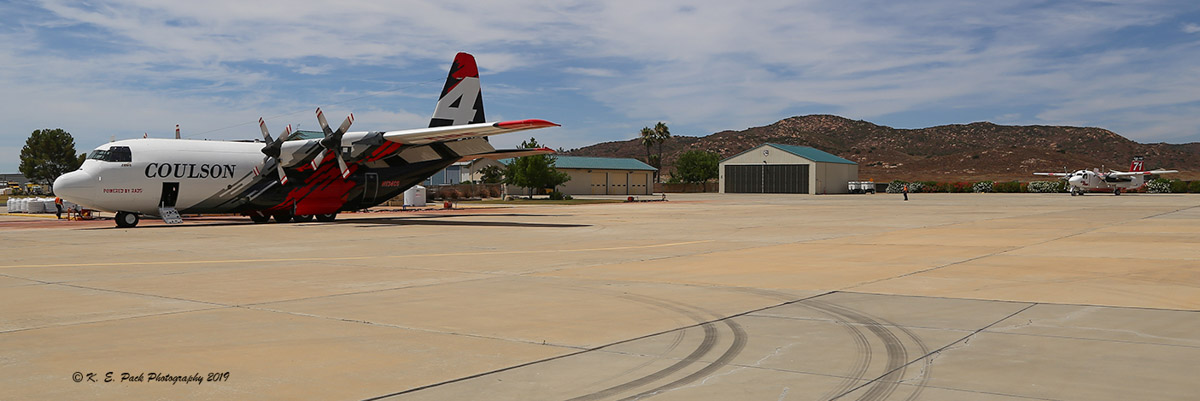(This article was first published at Fire Aviation)
It is unusual to see an air tanker larger than an S-2 at the Ramona Air Attack Base in Southern California, but a C-130Q under contract with the California Department of Forestry and Fire Protection (CAL FIRE) was seen at the base yesterday, August 3. Kevin Pack, who took the photo below, said it had been dropping on a fire, possibly the Sage Fire, in San Diego County.
The relatively short runway restricts which types of aircraft can use the facilities at Ramona. When the U.S. Navy built the airport in 1945 to be used as an emergency landing field it was only 4,000 feet long and remained that length well after it was conveyed to the County of San Diego in 1956.

CAL FIRE established an Air Attack Base there in 1957 and the U.S. Forest Service followed three years later.
The runway was lengthened in 2002 to 5,001 feet but it is difficult for some large air tankers and impossible for very large air tankers to work at the base. CAL FIRE has allowed BAe-146 air tankers under their CAL FIRE contracts to use the runway, but currently the Forest Service prohibits their large air tankers from using the airport.

CAL FIRE bases two S-2 air tankers and an Air Tactical Group Supervisor at the airport, and the Forest Service bases a helicopter there.
The S-2s can carry up to 1,200 gallons of retardant. In 2016 another Coulson C-130, T-131, completed 520 sorties averaging 3,404 gallons per load. A BAe-146 has a capacity of 3,000 gallons.
The C-130Q at Ramona on Saturday was Coulson’s Tanker 134, the fourth C-130 the company has converted. Its first drop on a fire was around November 1, 2018 while on a contract in Australia. It had just finished being reconfigured as an air tanker after being rescued from storage in Tucson and had not yet been painted.

CAL FIRE is using Tanker 134 to train their pilots who are transitioning from the S-2 air tankers to the seven HC-130Hs the agency has acquired after the U.S. Forest Service lost interest in the aircraft which were previously operated by the U.S. Coast Guard.

Hemet was an airtanker base when I went to the San Bernardino in 1981, and Hemet’s runway was 4312′. The CDF Unit Chief for RRU and I wrote a proposal to lengthen the runway before city expansion put this idea out of consideration, but it was denied. The aircraft contracting unit at Boise started giving us contracts for larger planes in the mid 80’s. By the early 90’s we were getting C-130 tankers.
I went to the base several times to look at the dirt runoffs–both ends of the runway. I could find C-130 tire tracks off the paved runway on both ends.
The Dept of Defense put Norton AFB on the closure list in 1992, and we applied for ownership of enough land to build an airtanker base at Norton. John Chambers was the Assistant Director of F&AM for aviation for several years. He was very positive about our intent to move to Norton. He and I retired the same day—-1/3/97.
Will keep an eye out for it’s use in Southern California fires